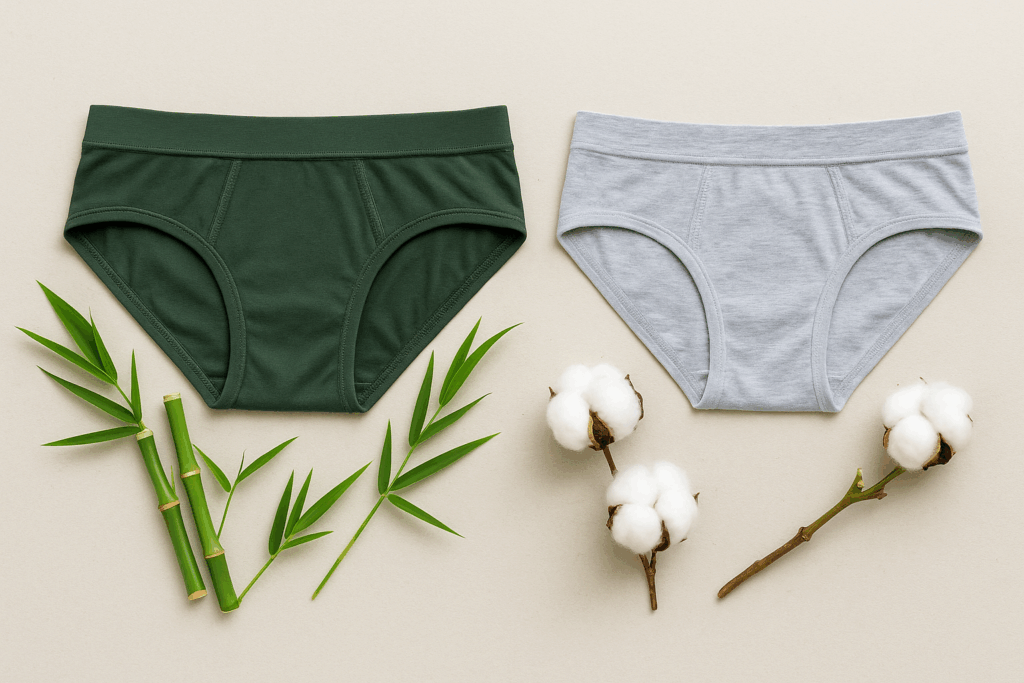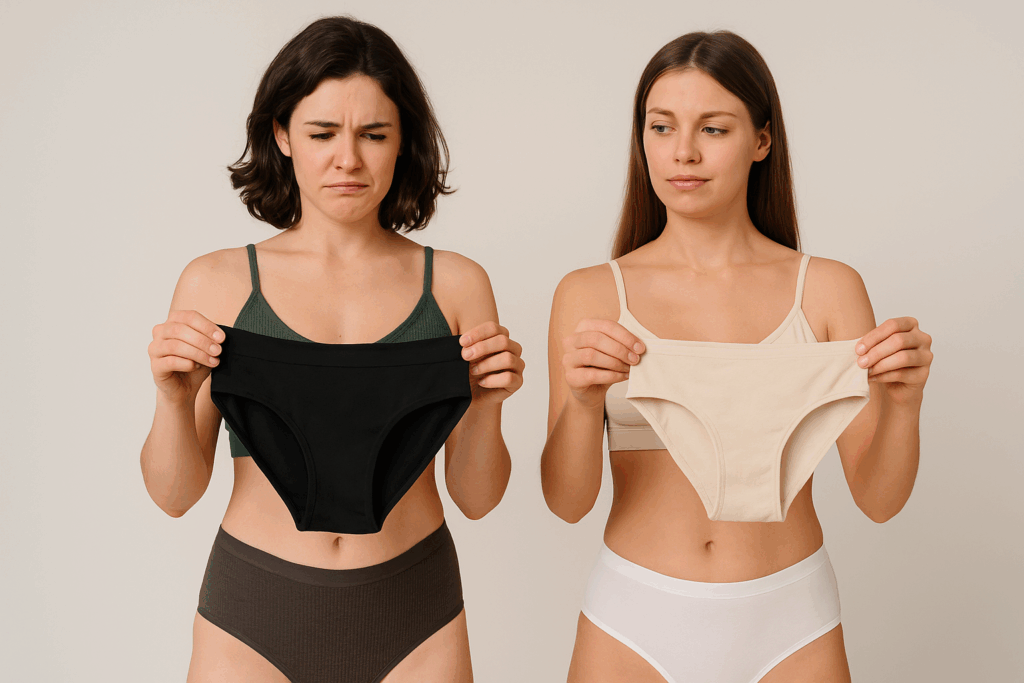Choosing underwear might seem straightforward, but when it comes to fabrics like bamboo and cotton, things get interesting fast. Both have their fans, with plenty of debate on which offers more comfort, durability, and health benefits. Let’s unpack the details to help you decide which fabric truly wins the comfort battle.

Understanding the Basics of Bamboo and Cotton Fabrics for Underwear
To appreciate why bamboo and cotton behave differently, it helps to understand what they are and how they’re made.
What Bamboo Fabric Is and How It’s Made
Bamboo fabric often surprises people. It’s not just raw bamboo chopped up and sewn into underwear. Instead, bamboo fibers are extracted through processes that turn the woody stalks into soft, wearable textiles. Most commonly, bamboo viscose is created by chemically processing bamboo pulp to dissolve it, then regenerating the fibers into threads [1].
This manufacturing gives bamboo fabric a silky feel, often described as softer than cotton. From a sustainability point of view, bamboo grows quickly and requires less water and pesticides, making it eco-friendly when processed responsibly [2]. But not all bamboo fabrics are created equal—processing methods can impact quality and environmental footprint.
What Cotton Fabric Is and Its Production Process
Cotton is a more familiar name in textiles. It comes from the natural fibers grew around cotton seeds. Harvested, cleaned, and spun into yarn, cotton fabric is celebrated for its softness, breathability, and versatility [3].
Conventionally, cotton farming is resource-heavy, demanding significant water and sometimes pesticides—though organic cotton aims to lessen this impact. Its widespread use means cotton underwear is plentiful and trusted [4].
Key Differences in the Material Properties of Bamboo and Cotton
Here’s a quick comparison:
- Softness: Bamboo tends to have a smoother texture due to its long, round fibers.
- Moisture management: Bamboo wicks moisture better than cotton, which can help keep things dry.
- Breathability: Both fabrics breathe well, but bamboo’s structure slightly edges out cotton.
- Durability: Cotton withstands wear well; bamboo can be less durable depending on processing [5].
Knowing these fundamentals sets the stage for looking deeply into comfort, care, and other factors.
Evaluating Comfort: Which Fabric Feels Better for Underwear?
So, which one feels better day-to-day? Comfort is personal, but science can guide us.
Comparing Softness and Texture of Bamboo and Cotton Underwear
Put bamboo and cotton side by side, and many find bamboo underwear feels silkier—almost luxurious. That’s due to bamboo’s smooth fibers, which create less friction against skin [6]. Cotton, especially combed cotton, can also be very soft but has a more “natural” texture.
For people with sensitive skin, bamboo’s gentle touch can reduce irritation. However, not everyone prefers the silky feel—some like cotton’s classic softness and familiar breathability.
Breathability and Moisture Management in Both Fabrics
Underwear should keep you dry and cool. Bamboo fabrics are excellent at wicking moisture away due to their porous fiber structure, which helps evaporate sweat quickly [7]. Cotton absorbs moisture but tends to hold onto it longer, potentially feeling damp when you sweat a lot.
If you live in a humid climate or work out regularly, bamboo’s superior moisture management can be more comfortable. But cotton does well in moderate conditions and remains breathable.
How Bamboo and Cotton Perform in Various Climate Conditions
Climate really influences fabric comfort. Bamboo underwear’s moisture-wicking and breathability make it great for hot or humid environments [8]. In colder weather, cotton keeps warmth trapped nearer the skin, which some appreciate.
For example, if you’re hiking in summer or in warm urban areas, bamboo underwear can help prevent chafing and discomfort. Conversely, cotton might suit cooler days when you want gentle warmth without overheating.
With an understanding of comfort, let’s see how these fabrics hold up over time.
Durability and Care Considerations for Bamboo and Cotton Underwear
Comfort fades if your underwear quickly wears out or goes limp after a few washes. How do bamboo and cotton stack up in durability?
Longevity and Resistance to Wear for Bamboo vs Cotton
Cotton ranks high on durability. Its fibers are naturally sturdy, especially when combed or blended with other fabrics. Bamboo fibers, being chemically processed, can weaken the yarn structure. As a result, bamboo underwear might show wear signs faster—things like thinning or pilling [9].
That said, bamboo blends, for example mixed with spandex or cotton, can improve longevity without losing softness. If you’re buying pure bamboo underwear, expect gentler care to preserve its life.
Recommended Washing and Maintenance Practices
To maintain bamboo underwear’s softness and integrity:
- Use cold or lukewarm water to wash.
- Avoid bleach or fabric softeners that can degrade fibers.
- Hang to dry rather than tumble dry, which can shrink or weaken fabric [10].
Cotton underwear is more forgiving—durable in hot washes and machine drying. Still, to keep color and softness, milder washing is better.
How Each Fabric Holds Up with Frequent Use and Wear
If your underwear faces daily heavy use, cotton may outlast bamboo under typical washing routines. Bamboo excels if you treat it more delicately—meaning fewer machine washes and gentle detergents.
Ultimately, your lifestyle and preference for maintenance can sway which fabric suits you better longevity-wise.
Health Benefits and Skin Sensitivity: Which Fabric Is Safer?
Many people choose underwear based on how their skin reacts. Let’s explore bamboo and cotton from a health perspective.

Hypoallergenic Qualities of Bamboo Compared to Cotton
Bamboo fabric is naturally hypoallergenic. Its fibers resist allergens and irritants, making it an excellent choice for sensitive or allergy-prone skin [11]. Cotton is also generally hypoallergenic but can vary depending on pesticide use and fabric treatment.
For eczema sufferers or those prone to irritation, bamboo underwear often results in less redness and itching.
Anti-Bacterial and Odor-Resistant Features of Both Fabrics
Thanks to natural bioagents in bamboo, its fabrics exhibit anti-bacterial properties, reducing odor-causing bacteria significantly [12]. Cotton, lacking these properties, can harbor bacteria longer unless treated.
This makes bamboo underwear a smart choice for active wearers or those concerned about odor, especially in warmer or stressful conditions.
Effects on Sensitive Skin, Irritation, and Allergies
If your skin is sensitive, bamboo’s smooth fibers and hypoallergenic nature generally cause fewer flare-ups or allergic reactions. Cotton is safe for many but sometimes, residual chemicals on non-organic cotton can trigger reactions [13].
If in doubt, look for organic cotton or bamboo underwear with minimal processing.
Environmental and Sustainability Factors Behind Bamboo and Cotton Underwear
Comfort doesn’t stop at your skin—it extends to how your choices impact the planet.
Comparing Farming Methods and Resource Usage
Bamboo grows rapidly, needs little water, and rarely relies on pesticides, making it an environmentally friendly crop [14]. Cotton, while renewable, often demands intense irrigation and chemical inputs, especially conventional varieties.
This difference can make bamboo underwear a better pick if sustainability ranks high for you.
Impact of Chemical Treatments and Fabric Processing
The twist? Bamboo’s processing often uses chemicals to convert the hard stalk into soft fabric, which can carry environmental risks if not managed properly [1]. Cotton cultivation, though pesticide-heavy, requires less chemical processing after fiber harvesting.
Some companies produce bamboo linen or mechanically processed bamboo that reduces chemical use—look for such certifications.
Biodegradability and Environmental End-of-Life Impact
Both bamboo and cotton are biodegradable and return to nature relatively quickly compared to synthetic fibers [15]. This is a significant advantage for reducing landfill waste.
So, bamboo underwear’s sustainability depends on farming, processing, and end-use practices.
Cost and Value Assessment: Is Bamboo Underwear Worth Its Price?
Before splurging, let’s talk dollars and sense.
Price Comparison and Market Availability of Bamboo vs Cotton
Bamboo underwear tends to be more expensive—sometimes significantly—due to processing costs and brand positioning as a premium fabric [16]. Cotton underwear is widely available at various price points, from budget to luxury.
If you want bamboo underwear, be prepared for a price premium.
Evaluating Cost-Per-Use Based on Durability and Care
While bamboo underwear feels luxurious, it may require gentler care and might wear out sooner, reducing cost-per-use value. Cotton, more robust in handling frequent washing, often lasts longer per dollar spent [9].
If you’re looking for durability and convenience, cotton holds an edge.
Consumer Preferences and Brand Variety in Bamboo and Cotton Options
Cotton underwear dominates the market with many style and brand choices for every budget. Bamboo options, while increasing, remain niche and often focused on sustainability and specialty benefits [16].
Try various brands with transparent sourcing to find what balances comfort and price for you.
Choosing the Right Fabric for Your Underwear Needs
Deciding between bamboo and cotton comes down to your lifestyle, preferences, and values.
Lifestyle and Preference Factors to Consider
- Active lifestyle, hot climates, or sensitive skin? Bamboo’s moisture-wicking and hypoallergenic properties make it the way to go.
- Frequent traveler or those who want easy care and durability? Cotton fits the bill better.
- Eco-conscious consumers must check certifications carefully to ensure bamboo’s environmental promises hold up.
When Bamboo Underwear Is the Better Choice
If you prioritize softness, odor resistance, and sustainability (with care), bamboo underwear is excellent. It’s especially suitable if you have sensitive skin or want an underwear upgrade for hot, humid conditions.
Situations Where Cotton Underwear Might Be More Suitable
Cotton underwear is your daily workhorse for durability, easy care, and cost-efficiency. It suits moderate climates and those who prefer fabric with a consistent, familiar feel. Plus, its wide availability means there’s something for everyone.
